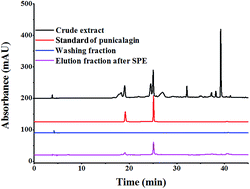Effect of polyethylene glycol as a molecular crowding agent on reducing template consumption for preparation of molecularly imprinted polymers
Abstract
The efforts in the present work focus on the topic of reducing template consumption in the preparation of molecularly imprinted polymers (MIPs). For this purpose, the effect of polyethylene glycol (PEG) as a molecular crowding agent on reducing template consumption in the preparation of MIPs was investigated. To prepare MIP monoliths with punicalagin, acrylamide was used as the functional monomer, and ethylene glycol dimethacrylate was the cross-linking monomer, with a mixture of PEG–THF–toluene as a porogen. It was found that the molecular weight of PEG, the ratio of the template to functional monomer, amount of PEG, level of DMF and the composition of the mobile phase greatly affected the retention of the template and the performance of molecular recognition. The PEG-based imprinted monolith still showed a specific imprinting effect even at the ratio of functional monomer to template of 1353 : 1. The optimal MIPs can be used as solid-phase extraction sorbents for the purification of punicalagin with a recovery of 85% and a purity of 97.7% from the crude extract of pomegranate-rind.


 Please wait while we load your content...
Please wait while we load your content...